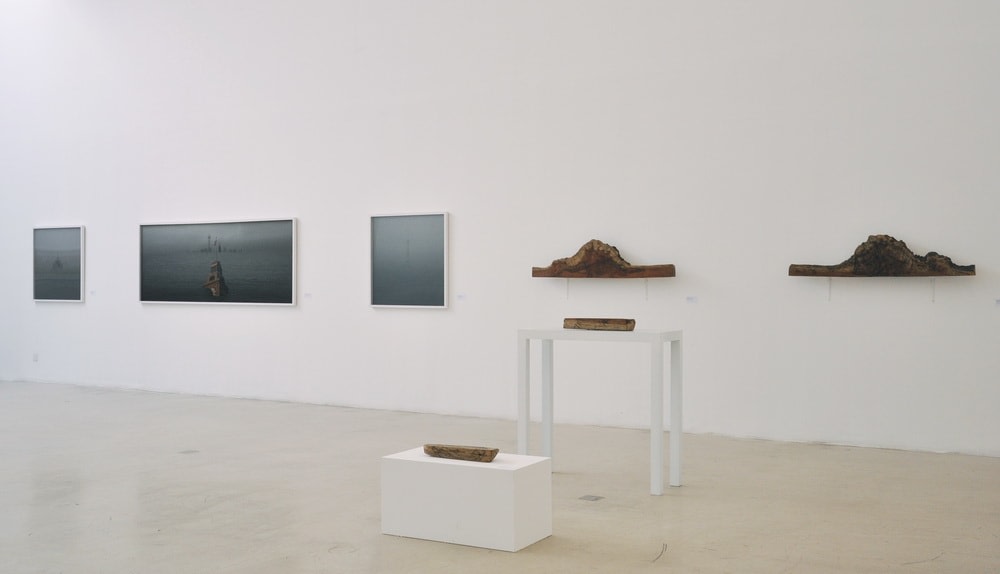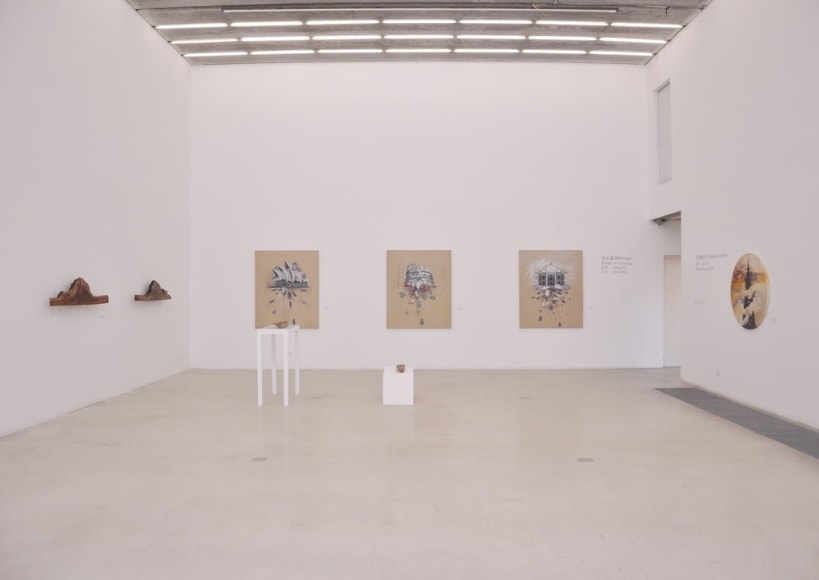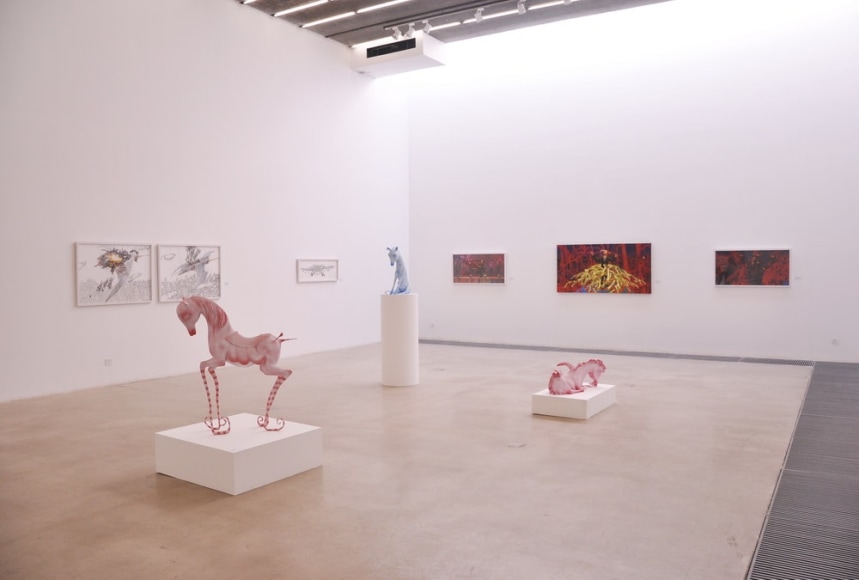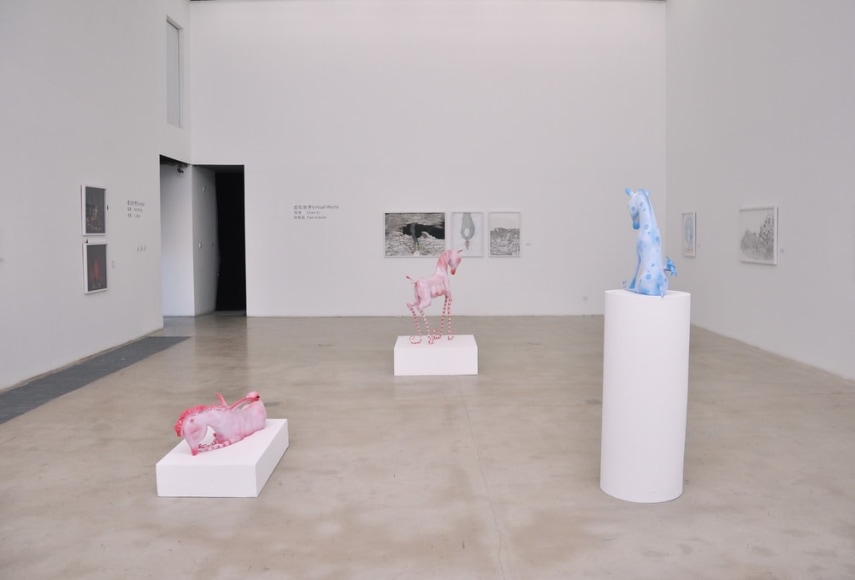With the New Year approaching, Chambers Fine Art Beijing is pleased to announce the opening of a young artists’ group show Nonexistent Reality on January 5, 2013. Starting from Midwinter 2009 to 2010, and Make It New in early spring 2011, to Nonexistent Reality this time around, these young artists’ group shows in our program exemplifies that Chambers has been increasingly focusing on younger artists, in addition to our consistent emphasis on established and mid-career artists.
The title Nonexistent Reality originates from The Truman Show, a dark comedy film. The film depicts a preposterous fable of life: the tragic character Truman is deceived and fooled all his life, living in a virtual world surveilled under numerous cameras. The film reflects multiple social issues such as human rights, freedom and privacy. Yet what is most impactful is the human desire for truth and freedom. In the ending, the ultimate puppeteer behind the scheme tells Truman that he has become the most popular star in the world, if he stays in this fictional world he can carry on his star life. Truman is however unconvinced and chooses to leave. Everybody has a different definition for the concept of truth. On a surface level, only what is visible to the naked eye can be regarded as real. But this reality is not singular. There is another reality deep inside our hearts. It is only peripheral to our vision but this reality holds great spiritual significance. The exhibition introduces the realities that are beyond human vision to our spiritual world, hoping to bring the viewer a unique otherworldly and “illusory” sensation.
The exhibition encompasses painting, sculpture, photography, video and other forms of expression. Nine young artists, San Shui, Peng Pi, Yi Guodong, Huang Haifei, Qiu Yun, Tian Xiaolei, Chen Xi, Han Peng and Li Zhen attempt to explicate the concept of “nonexistent reality” through four independent themes: Mirage, Butterfly Dream, Virtual World and Fairytale. The nine artists in the exhibition all have their own idiosyncratic forms of expression and conceptualization. San Shui’s (b. 1972) Bund series revolves around the architectural landscape and the human living experience. The foggy sea and landmarks on the Bund in Shanghai compose a poignant and mirage-like scene. Peng Pi (b. 1984) has chosen Vietnamese Huali wood as his canvas. Using a magnifier to focus light, he left burn marks resembling fossils of fish that no longer exists, transplanting past lives onto the Huali wood that is full of life, as a metaphor for rebirth. Yi Guodong (b. 1981) imagines war scenes from the future in a game-like manner. The playful tension between the war on the surface and the anti-war philosophy from Mo Gong exemplifies the artist’s sensitive imagination and rational contemplation on our current reality. Huang Haifei (b. 1983) breaks the rules by using the stamps that are important for purposes of authenticating name and status in traditional Chinese paintings to create fluid, lively and dream-like images. Underneath Qiu Yun’s (b. 1988) brushstrokes hides a girl’s sensitive dreamscape. Mystery, sweetness, danger and bizarreness are all parallel, inviting the viewer to the fascinating dream space. Tian Xiaolei (b. 1982) creates unique images by ways of digital modeling, depicting a group of white-collar workers running out of the subway after work towards the carnival island. The artist’s approach in pairing the imagery alluding to the spectacular and orderly National Day parade and the thrillingly wild fun at the amusement park “Happy Valley” is highly farcical and satirical. His utopian island seems to suggest that in this world of desire, the carnival island becomes the shelter and paradise, as well as the destination for the last indulgent rave party before the end of the world. Chen Xi (b. 1985) uses ink pens and watercolor to compose many fictional characters and stories. He explores in depth the humorous and weird characteristics of these fictive identities. For him, the nonsensical humor in the images is a true reflection of his inner world. Han Peng (b. 1982) makes use of many quotidian objects from our childhood and pointedly recreates a heartwarming scene for grown-ups – a fairytale in which a naïve little tin man leads an army of little objects to fight against the adult world. Li Zhen’s (b. 1989) work carries a toxic beauty and this beauty signifies very different things depending on the audience – “the most beautiful fairytale is not for children, because children themselves live in a fairytale, only adults, no longer possessing fairytale in their hearts, will be touched by fairytales.” The beautiful visual form of Li Zhen’s work is enhanced by its ironic humor.
In recent years, a growing number of art organizations start to focus more on the new forces of young artists, not only because young artists carry more vitality, but also for that the younger generation embodies the future direction of contemporary Chinese art. Our exhibition dates coincide with “slight cold” and “the beginning of spring” in the lunar calendar. We hope this shall be a good omen for next year’s artistic climate as spring arrives.
临近新年,北京前波画廊荣幸地宣布将于2013年1月5日起举办《不存在的真实》年轻艺术家群展。前波画廊从《2009 冬至2010》开始,到2011年新春伊始的《创新》,再到这次的《不存在的真实》,不难看出,多个年轻艺术家群展的推出体现了前波画廊近年来在一贯重视成熟艺术家的同时也把越来越多的目光转向年轻艺术家。
此次展览标题“不存在的真实”概念起源于一部黑色喜剧电影《楚门的世界》(The Truman Show)。电影描述了一个荒诞无稽的人生寓言:一位悲剧人物楚门一生被愚弄和欺瞒,生活在一个被无数镜头窥视下的虚拟世界。影片背后反映了人权、自由、隐私等诸多社会问题,然而,最令人印象深刻的是人类对真实和自由的渴求。电影结局时,那个幕后操纵者告诉楚门他现在已是世界上最受欢迎的明星,如果他愿留在这个虚构的世界就可继续明星生活,然而楚门不为所动,毅然离去。对“真实”的概念每个人有多种不同的理解。从表面来看,人类视觉范围内的事实就是真实,然而这种真实并非唯一,还有一种真实存在于人的内心深处,它游离于视觉之外却对人类的精神世界有着更为重要的作用。此次展览将人视觉所及之外的真实引入到人的精神世界,带给观者一种独特的“身临幻境”的体验。
本次展览涉及绘画、雕塑、摄影、影像等多种表现形式,由九位年青艺术家分四个不同的独立主题(海市蜃景、庄周晓梦、虚拟世界、童话故事)来阐述“不存在的真实”这一概念。参展的九位艺术家各具独特的造型方式和观念表达:三水(生于1972年)的《外滩》系列作品围绕着建筑景观与个人生存体验而展开,以迷雾中的大海与上海外滩标志性建筑组成一幕幕海市蜃楼般、同时又令人心悸的场景;彭丕(生于1984年)的作品采用越南黄花梨木作为画板,通过放大镜聚光在黄花梨上灼烧出那些早已不存在的鱼化石的形象,将已经逝去的生命体以质朴而简洁的方式附着在充满生命的黄花梨上,隐喻了重生;易国栋(生于1981年)通过游戏般的手法来描述未来世界的战争场景,藉由对画面表象的战争与背后《墨攻》“非战”理念的博弈,表达了艺术家对当下现实敏感的想象和理性的沉思;黄海菲(生于1983年)打破常规,将传统国画中用以署名、地位十分重要的印章作为画面形象和元素符号,来创造着一幅幅如梦境般自由流转、活灵活现的画面;裘昀(生于1988年)的笔触下隐藏着一个女孩细腻的梦境场面,神秘、甜美、惊险与诡异并存,使观者如置身其境;田晓磊(生于1982年)以电脑为工具建模图像并进行编序,描绘了一群上班族下班后从地铁蜂拥而出径直奔向乐园小岛上狂欢的场景,通过荒诞而戏谑的手法导演着一幕幕犹如国庆阅兵式热闹而整齐的场面和北京欢乐谷惊险的游戏与狂欢场景,他的乌托邦小岛似乎在向观者暗示:在这个欲望世界,乐园小岛是人们心灵的避难所和天堂,也是一场末日前放纵的狂欢聚会;陈熹(生于1985年)采用针管笔和水彩颜料配合在作品中创造了许多虚构的情节和人造形象,并努力发掘这些形象所呈现出幽默而古怪的特性,对他而言,画面中的无厘头趣味是他内心的真实反映;韩鹏(生于1982年)以许多童年时十分熟悉的日用小物件为背景,刻意营造一种对成年人来说极为温馨的氛围,描述了一个纯真的小铁皮人率领众多小物件擐甲执兵对抗成年人世界的童话故事;李震(生于1989年)是此次展览中最年轻的艺术家,他的雕塑作品中潜伏着一种毒药般的美丽,而这种美丽对不同观者具有截然不同的意义——“最美的童话不是给孩子读的,因为孩子本身就是童话,只有成人,因为不再有童话的心,才会为童话而感动”,使观者在领略其作品形式美的同时也感受到它的反讽趣味。
最近几年,越来越多的艺术机构更加重视新生力量,将焦点放到了年轻艺术家身上,不仅是因为年轻艺术家凝聚着更为鲜活的生命力,也是因为年轻一代身上肩负和代表着中国当代艺术未来的方向。此次展览恰逢小寒至立春,希望也能成为明年艺术氛围转暖回春¬¬¬的好兆头。




